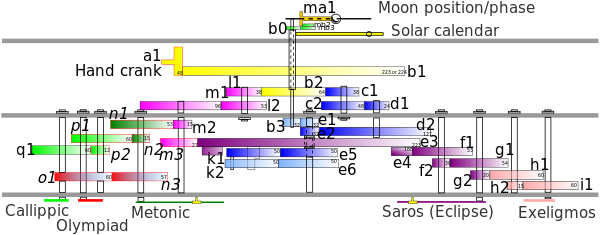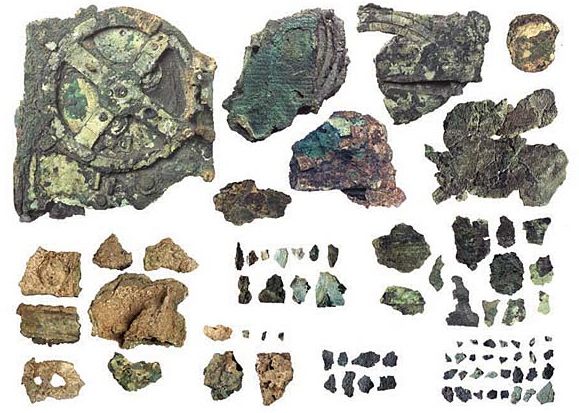The Antikythera Mechanism was discovered on May 17th 1902, by archaeologist Valerios Stais when he was diving on the Antikythera wreck off Point Glyphadia on the Greek island of Antikythera. The wreck is believed to have sunk in the 1st century BCE and has yielded many spectacular artifacts. The most mysterious of these is the Antikythera mechanism, a solid lump of corroded bronze gears. It has taken over a century, the latest imaging technology, and decades of research from a few dedicated scholars of mechanical engineering to piece together what the mechanism did.
I put together this playlist of short youtube videos. Together they describe the latest advances in understanding the mechanism and how it worked. There are four videos that take about 20 minutes to watch. Just click on the video and all four will play.
It appears that the mechanism is at last beginning to yield it’s secrets. The most staggering being that there was nothing else remotely like it for over 1400 years! It’s like a steam engine being found in Roman Britian, or a flying machine in Baghdad before the Monguls arrived. While we are beginning to understand how the mechanism worked, there is still little information on how it was used or what it means in terms of ancient Greek technical capabilities. Nothing else like the mechanism has been found but, it cannot have been unique in the ancient world. There are several references to machines with similar capabilities in contemporaneous Greek documents. Furthermore, the capabilities of the mechanism and the techniques required to build it clearly required a well established tradition of mechanical device construction.
The recent discovery of the inscriptions on the mechanism’s dials has led to a new theory. The spelling of the month names suggest that it was constructed at Syracuse on Sicily between 150 and 100 BCE. This leads to the tantalizing possibility that it was designed, or even built, by Archimedes who died in 212 BCE when Syracuse was taken by Roman forces. Cicero (106-43 BCE) mentions that, after the capture of Syracuse, two mechanisms which showed the motion of the Sun, Moon and five planets were taken back to Rome.
Then Philus said: I am not about to bring you anything new, or anything which has been thought over or discovered by me myself. But I recollect that Caius Sulpicius Gallus, who was a man of profound learning, as you are aware, when this same thing was reported to have taken place in his time, while he was staying in the house of Marcus Marcellus, who had been his colleague in the consulship, asked to see a celestial globe which Marcellus’s grandfather had saved after the capture of Syracuse from that magnificent and opulent city, without bringing to his own home any other memorial out of so great a booty; which I had often heard mentioned on account of the great fame of Archimedes; but its appearance, however, did not seem to me particularly striking. For that other is more elegant in form, and more generally known, which was made by the same Archimedes, and deposited by the same Marcellus in the Temple of Virtue at Rome. But as soon as Gallus had begun to explain, in a most scientific manner, the principle of this machine, I felt that the Sicilian geometrician must have possessed a genius superior to anything we usually conceive to belong to our nature. For Gallus assured us that that other solid and compact globe was a very ancient invention, and that the first 371model had been originally made by Thales of Miletus. That afterward Eudoxus of Cnidus, a disciple of Plato, had traced on its surface the stars that appear in the sky, and that many years subsequently, borrowing from Eudoxus this beautiful design and representation, Aratus had illustrated it in his verses, not by any science of astronomy, but by the ornament of poetic description. He added that the figure of the globe, which displayed the motions of the sun and moon, and the five planets, or wandering stars, could not be represented by the primitive solid globe; and that in this the invention of Archimedes was admirable, because he had calculated how a single revolution should maintain unequal and diversified progressions in dissimilar motions. In fact, when Gallus moved this globe, we observed that the moon succeeded the sun by as many turns of the wheel in the machine as days in the heavens. From whence it resulted that the progress of the sun was marked as in the heavens, and that the moon touched the point where she is obscured by the earth’s shadow at the instant the sun appears opposite.
On The Common Wealth, Book I XVI. Cicero
But this only raises new questions. If the greeks could manufacture astronomical devices of such spectacular precision and complexity what else could they do? Unfortunately we are left with only a few references by ancient historians who probably barely understood and only partially believed what they were documenting. These references include; burning mirrors that could set ships ablaze, and “claws” that could sink ships, automatons, and even vending machines. Unfortunately these brief references are all we have until someone pulls up another machine from the depths of the Mediterranean. But now at least we know that each of these descriptions may in fact refer to a real technology.

